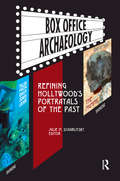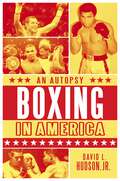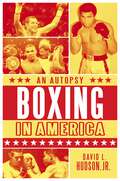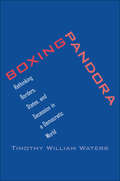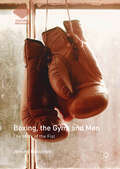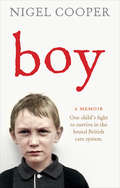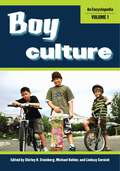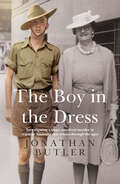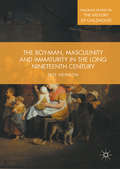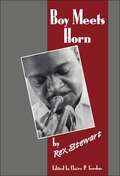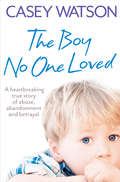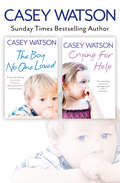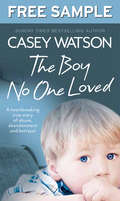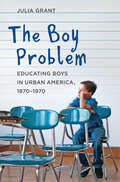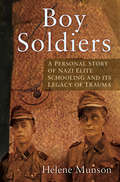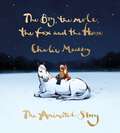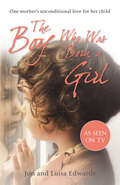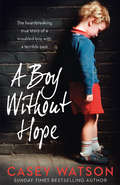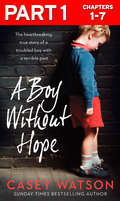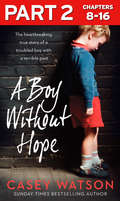- Table View
- List View
Box Office Archaeology: Refining Hollywood’s Portrayals of the Past
by Julie M. Schablitsky“How true is it?” is a common refrain of patrons coming out of movie theatres after the latest film on pirates, Vikings, or mummies. While Hollywood usurps the past for its own entertainment purposes, archaeologists and historians know a lot about many of these subjects, digging up stories often more fascinating than the ones projected on screen. This distinguished group of archaeologists select key subjects and genres used by Hollywood and provide the historical and archaeological depth that a movie cannot—what really happened in history. Topics include Egypt, the Wild West, Civil War submarines, Vikings, the Titanic, and others. The book should be of interest to introductory archaeology and American history classes, courses on film and popular culture, and to a general audience. Alternate Selection, History Book Club.
Boxed In: Making Identities Safe for Democracy
by Derrick Darby Eduardo J. MartinezOur lives take shape around identities. Race, religion, sexual orientation, and other collective identities impose scripts that dictate how we should think, act, and associate. African Americans should support reparations and affirmative action. Evangelical Christians should associate with true believers and feel outraged by same sex-marriage. Gays and lesbians should come out and engage in LBGTQ+ activism. When identities are scripted too tightly, we get boxed in and democracy suffers. In Boxed In, philosophers Derrick Darby and Eduardo J. Martinez diagnose the profound challenge that inflexible identities pose for democracy and offer a novel prescription that involves taking up civic responsibilities to search for, make visible, and attend to group differences in background, perspective, and empowerment. Collective action to pursue common projects under an identity--an abiding feature of democratic life--requires that we break free from tight scripts. Skeptics worry that the pervasive influence of identities on political reasoning and action make them unsafe for democracy. Optimists find identities too valuable in mobilizing political action to do without. Taking lessons from both sides, Darby and Martinez contend that optimists must qualify their acceptance of identity by mitigating the dangers that tightly-scripted collective identities pose for democratic collective action when group heterogeneity is disregarded. Using a wide range of examples from fútbol fans to Jay-Z's beef with Oprah, to literal box-checking on the U. S. Census, Darby and Martinez illustrate how scripting identities too tightly can box us in and they tell us what we can do to mitigate it. Weaving philosophical analysis with empirical research on identities, coalitions, and social movements, Boxed In prescribes making identities safe for democracy by undertaking responsibilities that help us break free from tight scripts that box us in and work together while taking our differences seriously.
Boxed In: Making Identities Safe for Democracy
by Derrick Darby Eduardo J. MartinezOur lives take shape around identities. Race, religion, sexual orientation, and other collective identities impose scripts that dictate how we should think, act, and associate. African Americans should support reparations and affirmative action. Evangelical Christians should associate with true believers and feel outraged by same sex-marriage. Gays and lesbians should come out and engage in LBGTQ+ activism. When identities are scripted too tightly, we get boxed in and democracy suffers. In Boxed In, philosophers Derrick Darby and Eduardo J. Martinez diagnose the profound challenge that inflexible identities pose for democracy and offer a novel prescription that involves taking up civic responsibilities to search for, make visible, and attend to group differences in background, perspective, and empowerment. Collective action to pursue common projects under an identity--an abiding feature of democratic life--requires that we break free from tight scripts. Skeptics worry that the pervasive influence of identities on political reasoning and action make them unsafe for democracy. Optimists find identities too valuable in mobilizing political action to do without. Taking lessons from both sides, Darby and Martinez contend that optimists must qualify their acceptance of identity by mitigating the dangers that tightly-scripted collective identities pose for democratic collective action when group heterogeneity is disregarded. Using a wide range of examples from fútbol fans to Jay-Z's beef with Oprah, to literal box-checking on the U. S. Census, Darby and Martinez illustrate how scripting identities too tightly can box us in and they tell us what we can do to mitigate it. Weaving philosophical analysis with empirical research on identities, coalitions, and social movements, Boxed In prescribes making identities safe for democracy by undertaking responsibilities that help us break free from tight scripts that box us in and work together while taking our differences seriously.
Boxing in America: An Autopsy
by David L. Jr.This book presents a sweeping view of boxing in the United States and the influence of the sport on American culture.Boxing has long been a popular fixture of American sport and culture, despite its decidedly seedy side (the fact that numerous boxing champions acquired their skills in prison or reform schools, the corruption and greed of certain boxing promoters, and the involvement of the mob in fixing the outcome of many big fights). Yet boxing remains an iconic and widely popular spectator sport, even in light of its decline as a result of the recent burgeoning interest in mixed martial arts (MMA) contests. What had made this sport so enthralling to our nation for such a long period of time?This book contains much more than simple documentation of the significant dates, people, and bouts in the history of American boxing. It reveals why boxing became one of America's leading spectator sports at the turn of the century and examines the factors that have swayed the public's perception of it, thereby affecting its popularity. In Boxing in America, the author provides a compelling view of not only the pugilist sport, but also of our country, our sources of entertainment, and ourselves.
Boxing in America: An Autopsy
by David L. Jr.This book presents a sweeping view of boxing in the United States and the influence of the sport on American culture.Boxing has long been a popular fixture of American sport and culture, despite its decidedly seedy side (the fact that numerous boxing champions acquired their skills in prison or reform schools, the corruption and greed of certain boxing promoters, and the involvement of the mob in fixing the outcome of many big fights). Yet boxing remains an iconic and widely popular spectator sport, even in light of its decline as a result of the recent burgeoning interest in mixed martial arts (MMA) contests. What had made this sport so enthralling to our nation for such a long period of time?This book contains much more than simple documentation of the significant dates, people, and bouts in the history of American boxing. It reveals why boxing became one of America's leading spectator sports at the turn of the century and examines the factors that have swayed the public's perception of it, thereby affecting its popularity. In Boxing in America, the author provides a compelling view of not only the pugilist sport, but also of our country, our sources of entertainment, and ourselves.
Boxing Pandora: Rethinking Borders, States, and Secession in a Democratic World
by Timothy William WatersA timely and provocative challenge to the foundations of our global order: why should national borders be unchangeable? The inviolability of national borders is an unquestioned pillar of the post–World War II international order. Fixed borders are believed to encourage stability, promote pluralism, and discourage nationalism and intolerance. But do they? What if fixed borders create more problems than they solve, and what if permitting borders to change would create more stability and produce more just societies? Legal scholar Timothy Waters examines this possibility, showing how we arrived at a system of rigidly bordered states and how the real danger to peace is not the desire of people to form new states but the capacity of existing states to resist that desire, even with violence. He proposes a practical, democratically legitimate alternative: a right of secession. With crises ongoing in the United Kingdom, Spain, Ukraine, Iraq, Syria, Sudan, and many other regions, this reassessment of the foundations of our international order is more relevant than ever.
Boxing, the Gym, and Men: The Mark of the Fist (Cultural Sociology)
by Jérôme BeauchezThis book explores the lived experiences of boxers in a French banlieue, largely populated by people from working-class and immigrant backgrounds. Jérôme Beauchez, who joined in the men’s daily workouts for many years, analyzes the act of boxing as a high-stakes confrontation that extends well beyond the walls of the gym. Exploring the physical and existential realities of combat, the author provides a multifaceted “thick description” of this world and shows that the violence faced by the gym’s members is not so much to be found in the ring as in the adversity of everyday racism and social exclusion. Boxing can therefore be understood as an act of resistance that is about more than simply fighting an opponent and that reflects all the existential struggles facing these men who are both stigmatized and socially dominated by race and class.
Boy: One Child's Fight to Survive in the Brutal British Care System
by Nigel Cooper“My parents had to try for eighteen months to conceive me, but my father was adamant he wanted one last child. After eighteen months of trying, my mother eventually conceived and nine months later I was born. My birth was a difficult one. It was like I was never meant to be in this world.” Boy is Nigel Cooper’s memoir from the age of five to sixteen. It tells the shocking, brutal, disturbing, emotional story of his childhood spent in and out of various care homes and institutions during the 1970s and 1980s. When Nigel was just seven years old, after the untimely death of his sister and father, his mother asked social services to take him away – and then his nightmare began. For the next nine years of his life, Nigel was repeatedly rejected by his mother and spent his childhood among bullies, abusers, psychopaths and criminals. He spent time in a children’s psychiatric hospital, where they carried out unimaginable tests, pumped him full of drugs and physically abused him; care homes, where he would come face to face with rough estate kids who would beat him up, force him to steal for them and threaten his life; and barbaric assessment centres for disturbed and delinquent children, where the staff were, at times, sicker than the children.The system tried to break Nigel and it was a miracle that he survived. The British care system robbed him of his childhood. His story is truly extraordinary and will do a lot more than shed light on what it was like growing up during the Jimmy Savile years.Boy is powerfully written, edgy, gripping and beautifully crafted.
Boy Culture [2 volumes]: An Encyclopedia [2 volumes]
by Shirley R. Steinberg Michael Kehler Lindsay CornishIn this two-volume set, a series of expert contributors look at what it means to be a boy growing up in North America, with entries covering everything from toys and games, friends and family, and psychological and social development.Boy Culture: An Encyclopedia spans the breadth of the country and the full scope of a pivotal growing-up time to show what "a boy's life" is really like today. With hundreds of entries across two volumes, it offers a series of vivid snapshots of boys of all kinds and ages at home, school, and at play; interacting with family or knocking around with friends, or pursuing interests alone as they begin their journey to adulthood.Boy Culture shows an uncanny understanding of just how exciting, confusing, and difficult the years between childhood and young adulthood can be. The toys, games, clothes, music, sports, and feelings—they are all a part of this remarkable resource. But most important is the book's focus on the things that shape boyhood identities—the rituals of masculinity among friends, the enduring conflict between fitting in and standing out, the effects of pop culture images, and the influence of role models from parents and teachers to athletes and entertainers to fictional characters.
The Boy in the Dress
by Jonathan ButlerAll rights reserved. No part of this publication may be reproduced without prior permission of the publisher.
The Boy-Man, Masculinity and Immaturity in the Long Nineteenth Century (Palgrave Studies in the History of Childhood)
by Pete NewbonThis book explores the evolution of male writers marked by peculiar traits of childlike immaturity. The ‘Boy-Man’ emerged from the nexus of Rousseau’s counter-Enlightenment cultural primitivism, Sensibility’s ‘Man of Feeling’, the Chattertonian poet maudit, and the Romantic idealisation of childhood. The Romantic era saw the proliferation of boy-men, who congregated around such metropolitan institutions as The London Magazine. These included John Keats, Leigh Hunt, Charles Lamb, Hartley Coleridge, Thomas De Quincey and Thomas Hood. In the period of the French Revolution, terms of childishness were used against such writers as Wordsworth, Keats, Hunt and Lamb as a tool of political satire. Yet boy-men writers conversely used their amphibian child-adult literary personae to critique the masculinist ideologies of their era. However, the growing cultural and political conservatism of the nineteenth century, and the emergence of a canon of serious literature, inculcated the relegation of the boy-men from the republic of letters.
Boy Meets Horn
by Rex StewartOne of the most innovative and inventive soloists in jazz, cornetist Rex Stewart (1907-67) became known as a writer on jazz subjects. This work, his autobiography drafted at the time of his death, has been edited from its manuscript sources by Stewart's amanuensis, who edited his earlier posthumous collection Jazz Masters of the Thirties. With a selection of rare photographs from Stewart's own archive, and mss. facsimiles.
The Boy No One Loved: A Heartbreaking True Story Of Abuse, Abandonment And Betrayal
by Casey WatsonSunday Times bestselling author and foster carer Casey Watson’s first heartbreaking memoir. Justin was five years old; his brothers two and three. Their mother, a heroin addict, had left them alone again. Later that day, after trying to burn down the family home, Justin was taken into care.
The Boy No One Loved and Crying for Help 2-in-1 Collection
by Casey WatsonSunday Times bestselling author and foster carer Casey Watson’s first heartbreaking memoir The Boy No One Loved now combined in a single volume with her shocking title Crying for Help about a troubled 12-year-old girl.
The Boy No One Loved: Free Sampler
by Casey WatsonDiscover the incredible memoirs of internationally bestselling author Casey Watson with this free extended eBook sampler of Casey’s first book, and Sunday Times bestseller, The Boy No One Loved.
The Boy Problem: Educating Boys in Urban America, 1870–1970
by Julia GrantAmerica’s educational system has a problem with boys, and it’s nothing new.The question of what to do with boys—the "boy problem"—has vexed educators and social commentators for more than a century. Contemporary debates about poor academic performance of boys, especially those of color, point to a myriad of reasons: inadequate and punitive schools, broken families, poverty, and cultural conflicts. Julia Grant offers a historical perspective on these debates and reveals that it is a perennial issue in American schooling that says much about gender and education today.Since the birth of compulsory schooling, educators have contended with what exactly to do with boys of immigrant, poor, minority backgrounds. Initially, public schools developed vocational education and organized athletics and technical schools as well as evening and summer continuation schools in response to the concern that the American culture of masculinity devalued academic success in school. Urban educators sought ways to deal with the "bad boys"—almost exclusively poor, immigrant, or migrant—who skipped school, exhibited behavioral problems when they attended, and sometimes landed in special education classes and reformatory institutions. The problems these boys posed led to accommodations in public education and juvenile justice system.This historical study sheds light on contemporary concerns over the academic performance of boys of color who now flounder in school or languish in the juvenile justice system. Grant's cogent analysis will interest education policy-makers and educators, as well as scholars of the history of education, childhood, gender studies, American studies, and urban history.
The Boy Problem: Educating Boys in Urban America, 1870–1970
by Julia GrantAmerica’s educational system has a problem with boys, and it’s nothing new.The question of what to do with boys—the "boy problem"—has vexed educators and social commentators for more than a century. Contemporary debates about poor academic performance of boys, especially those of color, point to a myriad of reasons: inadequate and punitive schools, broken families, poverty, and cultural conflicts. Julia Grant offers a historical perspective on these debates and reveals that it is a perennial issue in American schooling that says much about gender and education today.Since the birth of compulsory schooling, educators have contended with what exactly to do with boys of immigrant, poor, minority backgrounds. Initially, public schools developed vocational education and organized athletics and technical schools as well as evening and summer continuation schools in response to the concern that the American culture of masculinity devalued academic success in school. Urban educators sought ways to deal with the "bad boys"—almost exclusively poor, immigrant, or migrant—who skipped school, exhibited behavioral problems when they attended, and sometimes landed in special education classes and reformatory institutions. The problems these boys posed led to accommodations in public education and juvenile justice system.This historical study sheds light on contemporary concerns over the academic performance of boys of color who now flounder in school or languish in the juvenile justice system. Grant's cogent analysis will interest education policy-makers and educators, as well as scholars of the history of education, childhood, gender studies, American studies, and urban history.
Boy Soldiers: A Personal Story of Nazi Elite Schooling and its Legacy of Trauma
by Helene MunsonAt the end of the Second World War, hundreds of thousands of German children were sent to the front lines in the largest mobilisation of underage combatants by any country before or since. Hans Dunker was just one of these children. Identified as extremely gifted aged 9, he left his home in South America in 1937 in pursuit of a ‘proper’ education in Nazi Germany. Instead, he and his schoolfriends, lacking adequate training, ammunition and rations, were sent to the Eastern Front when the war was already lost in the spring of 1945. Using her father’s diary and other documents, Helene Munson traces Hans’ journey from a student at Feldafing School to a soldier fighting in Zawada, a village in present-day Czech Republic. What is revealed is an education system so inhumane that until recently, post-war Germany worked hard to keep it a secret. This is Hans’ story, but also the story of a whole generation of German children who silently carried the shame of what they suffered into old age. It reveals the true cost and long-lasting impacts of such experiences – not just to them, but also to their families and future generations, a warning to a world where thousands of child soldiers are still sent to fight in armed conflicts.
The Boy, The Mole, The Fox and The Horse
by Charlie MackesyA book for all ages, a book for all times, treasured by millions.Charlie Mackesy’s The Boy, the Mole, the Fox and the Horse was adapted into the BAFTA and Academy Award® winning animated short film.#1 SUNDAY TIMES BESTSELLER · #1 NEW YORK TIMES BESTSELLER“What do you want to be when you grow up?” asked the mole.“Kind,” said the boy.In this beautiful book, follow the tale of a curious boy, a greedy mole, a wary fox and a wise horse who find themselves together in sometimes difficult terrain, sharing their greatest fears and biggest discoveries about vulnerability, kindness, hope, friendship and love.“A wonderful work of art and a wonderful window into the human heart.” Richard Curtis
The Boy, the Mole, the Fox and the Horse: The Animated Story
by Charlie MackesyA journey, in search of homeCharlie Mackesy's beloved The Boy, the Mole, the Fox and the Horse has been adapted into an animated short film, coming to BBC One and iPlayer this Christmas.This beautifully made hardback celebrates the work of over 100 animators across two years of production - with Charlie's distinctive illustrations brought to life in full colour with hand-drawn traditional animation and accompanying hand-written script."I made a film with some friends about a boy, a mole, a fox and a horse - their journey together and the boy's search for home. I hope this book gives you courage and makes you feel loved." Love Charlie x
The Boy Who Built a Wall Around Himself (PDF)
by Ali Redford Kara SimpsonBoy built a wall to keep himself safe. Behind it he felt strong and more protected. Then Someone Kind came along. She bounced a ball, sang and painted on the other side of the wall, and Boy began to wonder if life on the other side might be better after all. Written for children aged 4 to 9, this gentle full-colour picture book uses a simple metaphor to explain how children who have had painful or traumatic experiences can build barriers between themselves and other people. It will help children explore their feelings and encourage communication.
The Boy Who Was Born a Girl: One Mother’s Unconditional Love for Her Child
by Jon Edwards Luisa EdwardsBrought up as female for fifteen years, Jon can remember feeling different from other girls since he was only five years old. But it will take years of depression, incessant bullying, self-harm and isolation before he discovers why.When Jon eventually confides to his mother that he feels like a boy, Luisa commits herself unconditionally to helping her child.For Jon, the changes that follow are his path to happiness. But for Luisa, this means coming to terms with the enormous loss of her daughter.
A Boy Without Hope
by Casey WatsonA BOY WITHOUT HOPE is the heart-breaking story of a boy who didn’t know the meaning of love. A history of abuse and neglect has left Miller destined for life’s scrap heap. But in this turbulent story of conflict and struggle, Casey Watson is determined to help Miller overcome his demons, show him love and give him hope.
A Boy Without Hope: Part 1 of 3
by Casey WatsonA BOY WITHOUT HOPE is the heart-breaking story of a boy who didn’t know the meaning of love. A history of abuse and neglect has left Miller destined for life’s scrap heap. But in this turbulent story of conflict and struggle, Casey Watson is determined to help Miller overcome his demons, show him love and give him hope.
A Boy Without Hope: Part 2 of 3
by Casey WatsonA BOY WITHOUT HOPE is the heart-breaking story of a boy who didn’t know the meaning of love. A history of abuse and neglect has left Miller destined for life’s scrap heap. But in this turbulent story of conflict and struggle, Casey Watson is determined to help Miller overcome his demons, show him love and give him hope.
